Mausoleum of Augustus
| Mausoleum of Augustus | |
|---|---|
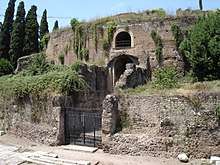 | |
| Location | Campus Martius |
| Built in | 28 BC |
| Built by/for | Augustus |
| Type of structure | Mausoleum |
| Related |
List of ancient monuments in Rome |
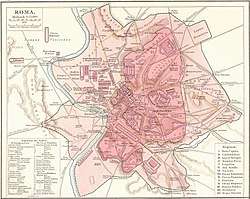 Mausoleum of Augustus | |
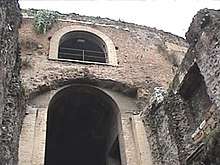
The Mausoleum of Augustus (Italian: Mausoleo di Augusto) is a large tomb built by the Roman Emperor Augustus in 28 BC on the Campus Martius in Rome, Italy. The mausoleum is located on the Piazza Augusto Imperatore, near the corner with Via di Ripetta as it runs along the Tiber. The grounds cover an area equivalent to a few city blocks, and nestle between the church of San Carlo al Corso and the Museum of the Ara Pacis. The mausoleum is currently in the process of a restoration with a prospective completion date of April 2019, upon which it will open to the public.[1][2]
Description
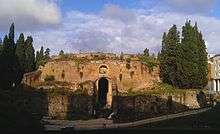
The mausoleum was one of the first projects initiated by Augustus in the City of Rome following his victory at the Battle of Actium in 31 BC. The mausoleum was circular in plan, consisting of several concentric rings of earth and brick, faced with travertine on the exterior, and planted with cypresses on the top tier. The whole structure was capped (possibly, as reconstructions are unsure at best) by a conical roof and a huge bronze statue of Augustus.
Vaults held up the roof and opened up the burial spaces below. Twin pink granite obelisks flanked the arched entryway; these have been removed; one now stands at the Piazza dell'Esquilino (on the northwest side of the Basilica of Santa Maria Maggiore) and the other at the Quirinal fountain. The completed mausoleum measured 90 m (295 ft) in diameter by 42 m (137 ft) in height.
A corridor ran from the entryway into the heart of the mausoleum, where there was a chamber with three niches to hold the golden urns enshrining the ashes of the Imperial Family. Two pillars flanking the entrance were mounted with bronze plaques inscribed with the Res Gestae Divi Augusti, the document describing Augustus' accomplishments and victories.[3] Surrounding the mausoleum was landscaped parkland akin to modern public parks, affording a place of retreat at the heart of Rome's heavily urbanized Campus Martius.
Post-Classical history
The traditional story is that in 410, during the sack of Rome by Alaric, the pillaging Visigoths rifled the vaults, stole the urns and scattered the ashes, without damaging the structure of the building (Rodolfo Lanciani). Platner and Ashby, however, posited that "The story of its plundering by Alaric in 410 has no historical foundation, and we know nothing of its destruction".[4]
In the Middle Ages the tumulus was fortified as a castle— as was the mausoleum of Hadrian, which was turned into the Castel Sant'Angelo— and occupied by the Colonna family. After the disastrous defeat of the Commune of Rome at the hands of the Count of Tusculum in 1167, the Colonna were disgraced and banished, and their fortification in the Campo was dismantled. Throughout the Renaissance it passed through the ownership of several major Roman families, who used it as a garden; at the beginning of the 19th century it was in use as a circus.[5]
In the early 20th century, the interior of the Mausoleum was used as a concert hall called the Augusteo,[6] until Mussolini ordered it closed in the 1930s and restored it to the status of an archaeological site. The restoration of the Mausoleum of Augustus to a place of prominence featured in Benito Mussolini's ambitious reordering of the city of Rome which strove to connect the aspirations of Italian Fascism with the former glories of the Roman Empire. Mussolini viewed himself especially connected to the achievements of Augustus, seeing himself as a 'reborn Augustus' ready to usher in a new age of Italian dominance.
Restoration
In January 2017, Italian authorities announced that due to a €6 million grant from Telecom Italia the Mausoleum of Augustus would receive a comprehensive restoration that will allow it to open to the public for the first time since the 1970s.[7] When the Mausoleum opens in April 2019 it will be fully restored and incorporate a multi-media exhibition that will project images of modern and ancient Rome onto the interior walls of the structure.[8]
An earlier intention to restore the Mausoleum in time to commemorate the 2,000th anniversary of Augustus' death in 2014 failed due to funding shortfalls.[9] The neglect of the Mausoleum, closed to the public, overgrown with vegetation and used as a dumping ground for litter, had long attracted criticism, especially after the opening of the Ara Pacis museum across the street in 2006.[10]
Buried inside
Included among those whose remains were laid inside the mausoleum before the death of Augustus were:
- Marcus Claudius Marcellus (who was the first to be buried there, in 23 BC),
- Marcus Vipsanius Agrippa in 12 BC,
- Nero Claudius Drusus in 9 BC,
- Octavia Minor (the sister of Augustus) in 9 or 11 BC,
- Gaius Caesar and Lucius Caesar, grandsons and heirs of Augustus.
After the death of Augustus, the mausoleum hosted the ashes of:
- Livia (Augustus's wife),
- Germanicus,
- Agrippina the Elder,
- Agrippina's daughter Julia Livilla,
- Nero Julius Caesar,
- Drusus Caesar (son of Germanicus),
- Caligula,
- Tiberius,
- Drusus Julius Caesar (son of Tiberius),
- Antonia Minor (mother of Claudius),
- Claudius,
- Britannicus (the son of Claudius),
- the embalmed body of Poppaea Sabina wife of Nero,
- Nerva, the last emperor for whom the mausoleum was opened.
- Julia Drusilla Daughter of Caligula
See also
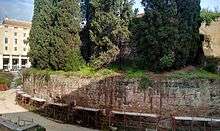

References
- ↑ Sarah Bond (2017-05-08). "Take a Look at the New Renovations of the Mausoleum of Augustus Caesar". Forbes.com. Retrieved 2017-08-07.
- ↑ Nick Squires (2017-01-16). "Giant mausoleum in Rome that held the remains of the emperor Augustus to be restored after decades of neglect". The Daily Telegraph. Retrieved 2017-08-07.
- ↑ Cf. Mitt. 1904, 57; Kornemann, Mausoleum und Tatenbericht des Augustus, 16.
- ↑ Platner & Ashby (1929). A Topographical Dictionary of Ancient Rome. p. 332–336.
- ↑ Platner & Ashby (1929). A Topographical Dictionary of Ancient Rome. p. 332–336.
- ↑ Platner & Ashby (1929). A Topographical Dictionary of Ancient Rome. p. 332–336.
- ↑ Nick Squires (2017-01-16). "Giant mausoleum in Rome that held the remains of the emperor Augustus to be restored after decades of neglect". The Daily Telegraph. Retrieved 2017-08-07.
- ↑ Nick Squires (2017-01-16). "Giant mausoleum in Rome that held the remains of the emperor Augustus to be restored after decades of neglect". The Daily Telegraph. Retrieved 2017-08-07.
- ↑ Lizzy Davies (2014-08-19). "Mausoleum of Augustus stands derelict on anniversary of emperor's death". The Guardian. Retrieved 2017-08-07.
- ↑ Sarah Bond (2017-05-08). "Take a Look at the New Renovations of the Mausoleum of Augustus Caesar". Forbes.com. Retrieved 2017-08-07.
External links
| Wikimedia Commons has media related to Mausoleum of Augustus. |
Coordinates: 41°54′22″N 12°28′35″E / 41.90611°N 12.47639°E